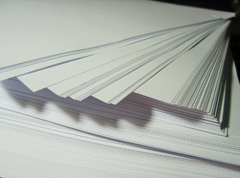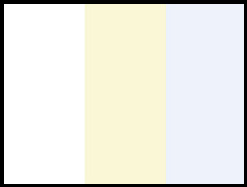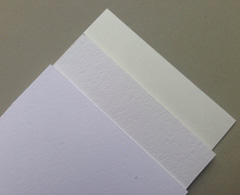| ALL ABOUT PAPER WHITENESS |
 |
|
The terms "brightness" and "whiteness" are often used interchangeably when considering paper. While for the regular layperson this crossover may not be detrimental, it is an important differentiation for those involved in the printing and art realms.
Brightness is the measure of the amount of blue light reflected off a sheet of paper. Essentially the volume of light.
Whiteness is the measure of the amount of all light reflected off a sheet of paper. Essentially the quality of light.
This article will deal with paper whiteness; what it is, how it is determined, and how it affects print quality.
To read more, see our All About Brightness article.
|
SUMMARY
| WHAT IS WHITENESS? |
SHADES |
TESTING |
PRINT RESULTS |
| Whiteness is the measurement of how much light from every spectrum (ie: white light) is reflected off the surface of the paper. Whiteness is rated by shade or a percentage. |
In lieu of a whiteness percentage a name, called the shade, may be applied to the paper. The three basic shade designations are: True white, Blue white, and Cream white. |
Whiteness is determined using the D65 Illumination Whiteness Test. This test determines the amount of natural light reflected off the paper's surface. |
The whiteness of a paper will affect how the printed image appears upon it. Bright white papers provide more contrast and a wider gamut. |
|
| WHAT IS WHITENESS?
|
 |
|
Whiteness is the measurement of all visible light reflected off the surface of a sheet of paper. The combination of all light wavelengths is white, hence the name.
Because Whiteness is calculating the "white" light reflected off the surface of the paper, it is a more reliable determination of how white the paper appears to the human eye than the Brightness rating. Similarly, whiteness will affect the color of a printed image.
Since a specific type or mixture of light is used to test it, however, a paper considered very white could still appear otherwise under different lighting.
Whiteness is measured on a scale of 1-100%. It is generally quite simple to pick out the whiter/whitest paper, at least under the test lighting conditions, while Brightness is generally a harder quality to pinpoint visually.
Any glossy coating must be taken into consideration when visually assessing whiteness, as well, as the paper's appearance will be altered by this added, reflective surface.
|

|
| SHADE DESIGNATIONS FOR PAPER
|
 |
|
Shade is basically a subcategory of Whiteness. While the percentage rating may sometimes be used by the manufacturer to define whiteness, other companies will identify it by a name describing the "type of white". There are three basic breakdowns for shade, though they are known by different names.
Unfortunately, shade names are not standardized, so you should never assume two different papers are the same just because they share a shade name.
- Blue White is often used, as it appears whiter to the eye. Blue white papers absorb yellows and warmer wavelengths and reflect blue or cooler wavelengths.
- Cream White papers have a yellowish tint, due to the fact they absorb blues and cooler colors, and reflect yellows and warmer colors. Cream white may also be called "warm white".
- True White refers to papers that reflect all wavelengths equally. Therefore, under the correct lighting conditions they will appear absolutely white. True white is also known as "balanced white".
Though the most common shade in art and printing papers used to be True White, today Blue White is more common, as more designers prefer a cool, brilliant white to the warmer, "natural" shade.
|

True White; Cream White; Blue White
|
| PAPER WHITENESS STANDARD TEST
|
 |
|
The most commonly used whiteness test (not only for paper, but also paints, plastics, and other surface colorants) is the D65 Illumination Whiteness Test. It is also known as the ISO 11475 Whiteness Test.
The test is conducted using a light source of outdoor daylight, and the resulting rating is called the CIE Whiteness Standard, as it is set by the International Commission on Illumination (CIE).
Specifically this D65 test corresponds to what is approximately midday sun in Western and Northern Europe. Despite this focus on natural light, light simulators are used for the test in lieu of real sunlight. This simulation is the CIE D65 daylight illuminant,
The test also includes a standardized way of adjusting the data based on the UV content when artificial brighteners have been used in the paper.
|

Text
|
| HOW WHITENESS AFFECTS THE PRINT
|
 |
|
This chart shows the whiteness of each fine art paper type we offer at KeenART Media. Where a percentage is not available, the shade is given instead.
| FINE ART PAPERS |
WHITENESS |
| Hahnemühle Photo Rag |
92.5 % |
| Hahnemühle German Etching |
91.5 % |
| Hahnemühle William Turner |
88.5 % |
| Hahnemühle FineArt Baryta |
103 % |
| Hahnemühle FineArt Pearl |
105 % |
| Epson UltraSmooth Hot Press |
Natural White |
| Epson Enhanced Matte |
Bright White |
An image printed on a glossy paper will, naturally, be more reflective than the same image printed on matte, textured papers. This is because the light is reflected readily off the surface of the coated paper, and is diffused (scattered) across the surface of the uncoated paper.
Papers with a high whiteness rating will reflect more light, therefore allowing for more contrast in the printed image. High brightness and whiteness also tends to correlate with wide color gamut. These papers are useful for digital art and brightly colored art reproductions, because the eye is accustomed to seeing the image with a great deal of contrast and saturation (on the computer screen, or on a white-primed canvas).
Papers that are less white will have less contrast and a lower color gamut. This may be a desirable choice for reproductions of sketches, charcoal, and other, less color-centric artwork we are accustomed to viewing in this way.
Most photographic papers are very white and bright. If, however, an antique or less saturated appearance is desired, a less white fine art paper is an alternative.
Though different papers will always prouce slightly different results, a good print technician will know how to alter the digital image to suitably compensate in most instances.
|

Left to right: Photo Rag; German Etching; Enhanced Matte
|
|
At KeenART Media, we use a variety of different fine art and photographic papers. Visit our Fine Art Prints page to see the full list of papers we offer.
If you have questions about any of our fine art paper prints, or any of our other services or products, don't hesitate to contact us. Our knowledgeable staff is always happy to assist with answers, advice, or suggestions.
|
|
© 2002-2025 - KeenART Media Ltd.
|
|
| |
|

